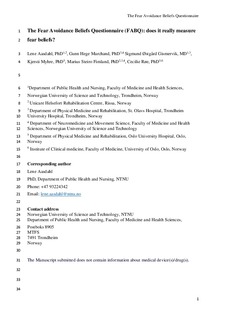| dc.contributor.author | Aasdahl, Lene | |
| dc.contributor.author | Marchand, Gunn Hege | |
| dc.contributor.author | Gismervik, Sigmund Østgård | |
| dc.contributor.author | Myhre, Kjersti | |
| dc.contributor.author | Fimland, Marius Steiro | |
| dc.contributor.author | Røe, Cecilie | |
| dc.date.accessioned | 2020-01-20T09:48:30Z | |
| dc.date.available | 2020-01-20T09:48:30Z | |
| dc.date.created | 2019-08-25T13:54:52Z | |
| dc.date.issued | 2019 | |
| dc.identifier.issn | 0362-2436 | |
| dc.identifier.uri | http://hdl.handle.net/11250/2636958 | |
| dc.description.abstract | Study Design.
A cohort study with 12 months of follow-up.
Objective.
To assess (1) the unidimensionality of the Fear-Avoidance Beliefs Questionnaire (FABQ) and (2) whether single questions in the FABQ predict future sickness absence as well as the whole scale.
Summary of Background Data.
The fear-avoidance model is a leading model in describing the link between musculoskeletal pain and chronic disability. However, reported measurement properties have been inconsistent regarding the FABQ.
Methods.
Individuals (n = 722) sick listed due to musculoskeletal, unspecified or common mental health disorders undergoing rehabilitation was included. A Rasch analysis was applied to evaluate the measurement properties of FABQ and its two subscales (physical activity and work). Linear regression was used to assess how well single items predicted future sickness absence.
Results.
The Rasch analysis did not support the FABQ or its two subscales representing a unidimensional construct. The 7-point scoring of the items was far too fine meshed and in the present population the data only supported a yes or no or a 3-point response option. The items were invariant to age, whereas two of the items revealed sex differences. The item “I do not think that I will be back to my normal work within 3 months” was the best predictor of future sickness absence. Adding the item “I should not do my regular work with my present pain” improved the prediction model slightly.
Conclusion.
The FABQ is not a good measure of fear-avoidance beliefs about work or physical activity, and the predictive property of the FABQ questionnaire is most likely related to expectations rather than fear. Based on these results we do not recommend using the FABQ to measure fear-avoidance beliefs.
Level of Evidence: 1 | nb_NO |
| dc.language.iso | eng | nb_NO |
| dc.publisher | Lippincott, Williams & Wilkins | nb_NO |
| dc.rights | Navngivelse-Ikkekommersiell 4.0 Internasjonal | * |
| dc.rights.uri | http://creativecommons.org/licenses/by-nc/4.0/deed.no | * |
| dc.title | The Fear Avoidance Beliefs Questionnaire (FABQ) Does it really measure fear beliefs? | nb_NO |
| dc.type | Journal article | nb_NO |
| dc.type | Peer reviewed | nb_NO |
| dc.description.version | acceptedVersion | nb_NO |
| dc.source.journal | Spine | nb_NO |
| dc.identifier.doi | 10.1097/BRS.0000000000003188 | |
| dc.identifier.cristin | 1718507 | |
| dc.relation.project | Norges forskningsråd: 238015 | nb_NO |
| dc.description.localcode | © 2019. This is the authors' accepted and refereed manuscript to the chapter. Locked until 15.1.2021 due to copyright restrictions. The final authenticated version is available online at: http://dx.doi.org/10.1097/BRS.0000000000003188 | nb_NO |
| cristin.unitcode | 194,65,20,0 | |
| cristin.unitcode | 1920,5,0,0 | |
| cristin.unitcode | 194,65,30,0 | |
| cristin.unitname | Institutt for samfunnsmedisin og sykepleie | |
| cristin.unitname | Klinikk for fysikalsk medisin og rehabilitering | |
| cristin.unitname | Institutt for nevromedisin og bevegelsesvitenskap | |
| cristin.ispublished | true | |
| cristin.fulltext | postprint | |
| cristin.qualitycode | 2 | |

